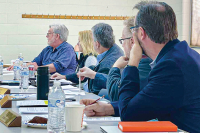A book about the paths most traveled

In my younger years, I used to do a lot of hiking. I would follow footpaths and trails or blaze my own way through the woods or along streams and rivers. While those trailblazing days are over, I get my more physical outdoor thrills vicariously from writers like Robert Moor, who travels all over the planet experiencing different ecosystems and terrain to whet his appetite and intellect.
In his 2016 New York Times bestseller, “On Trails: An Exploration,” we meet him in the book’s Prologue walking the length of the Appalachian Trail, a journey of “wet stone and black earth” as he describes it and “looking for answers to how pathways act as an essential guiding force on this planet.”
Concluding, early on, with the statement “without trails we would be lost,” he proceeds to take us, chapter by chapter, on his personal journeys and experiences tracking and tracing different trails here in North America and abroad. He talks about evolution. He talks about paths (trails) as being a spiritual experience. Conjuring up the spirit of Robert Frost he ruminates: “Our history is one of many paths we might have taken, but it was the one we took.” He then launches us into the body of this book with the essential thesis statement of “we need to understand how to make trails and how trails make us.”
Throughout the 340 pages in “On Trails,” Moor takes us on ant (“arguably the world’s greatest trail-makers”) and fossil trails in Newfoundland, African elephant trails in the Six Flags Adventure Theme Park in New Jersey, Navaho sheep trails in Black Mesa, Arizona, hunting deer in the northern Adirondacks of New York, tracking buffalo on the Old Jasper Road in Alabama, human trails on and off the Appalachian Trail, and, finally, on the IAT international “supertrail” of some 14,000 miles from the state of Georgia to the country of Morocco. All of these journeys that he creates in brilliantly personal prose take us inevitably, as he says, to the conclusion that “we are, each of us, wild to our marrow” — giving us remarkable insights into these various insects and animals (including ourselves) in the context that the journey along Earth’s pathways “is not labor, not work, but a dance.”
Citing members of the eco-aristocracy from Thoreau, Muir and Gary Snyder to Aristotle and the Chinese poet Han Shan, Moor’s research on his subject is profound, if not staggering. But, science aside, the book’s true essence, for this reader, comes in his autobiographical accounts in actual places with actual people who know the terrain and have lived lifetimes on the land. In that sense, his accounts of shepherding sheep on the Navaho reservation and his experiences on the Appalachian Trail are what held my rapt attention.
For those of us living here in western North Carolina, you may be, as I was, most interested in the long AT sections. Here, I was both surprised and thrilled to read of Moor’s accounts of time spent with people that I, too, have spent time with and know. People who know these mountains here in Cherokee country as well as anyone. We spend a lot of time with Lamar Marshall, who has slowly but diligently for many years now been piecing together a map of all the major footpaths of the ancient Cherokee homeland. As Moor quotes: “For many indigenous people, the land served as a library of botanical, zoological, geographical, etymological, ethical, genealogical spiritual, cosmological, and esoteric knowledge.” Mile by mile Marshall is incorporating the human landscape back into the natural one — everything from Little Frog, Big Snowbird, Devil’s Den Ridge, Fire’s Creek and Carver’s Gap to what he calls “Big Stamp” or the pathways defining the infamous Trail of Tears.
Related Items
Moor also spends much time in these southernmost Appalachians with full-blood Cherokee Gilliam Jackson, better known as “Gil,” from over in the Snowbird community who is a legendary harsh terrain hiker and the founder of the Kituwah Academy focusing on Cherokee culture and language and embracing the idea that “Indigenous cultures need both language and land to survive.” On page 180 we also meet folklorist Barbara Duncan, who spent decades recording Cherokee myths and legends where “almost every prominent rock and mountain, every deep bend in the river, in the old Cherokee country has its accompanying legend.”
Aside from the familiar Western North Carolina mountains and their spiderweb of paths and trails, Moor in “On Trails” takes us, if briefly, to faraway places like Aboriginal Australia, Papua, New Guinea, Bolivia and New Zealand. As he states, “Walking creates trails. Trails, in turn, shape landscapes. And, over time, landscapes come to serve as archives of communal knowledge and symbolic meaning.”
Toward the end of the book Moor talks about environmental and cultural erosion. “We have lost the elemental bond between foot and earth,” he says. He laments the disconnect between modern technological culture and “wilderness,” or the “not self” as he names it, and yearns for what the Cherokee call tohi denoting “something, or everything, that is moving at its own speed, utterly at peace — where trail-builders build trails that both preserve the integrity of the land and fulfill the hiker’s desires — “creating connections: of people, of ecosystems, of countries, of continents, and of geologic epochs.”
(Thomas Crowe is a regular contributor to The Smoky Mountain News and author of the award-winning environmental memoir Zoro’s Field: My Life in the Appalachian Woods.)









